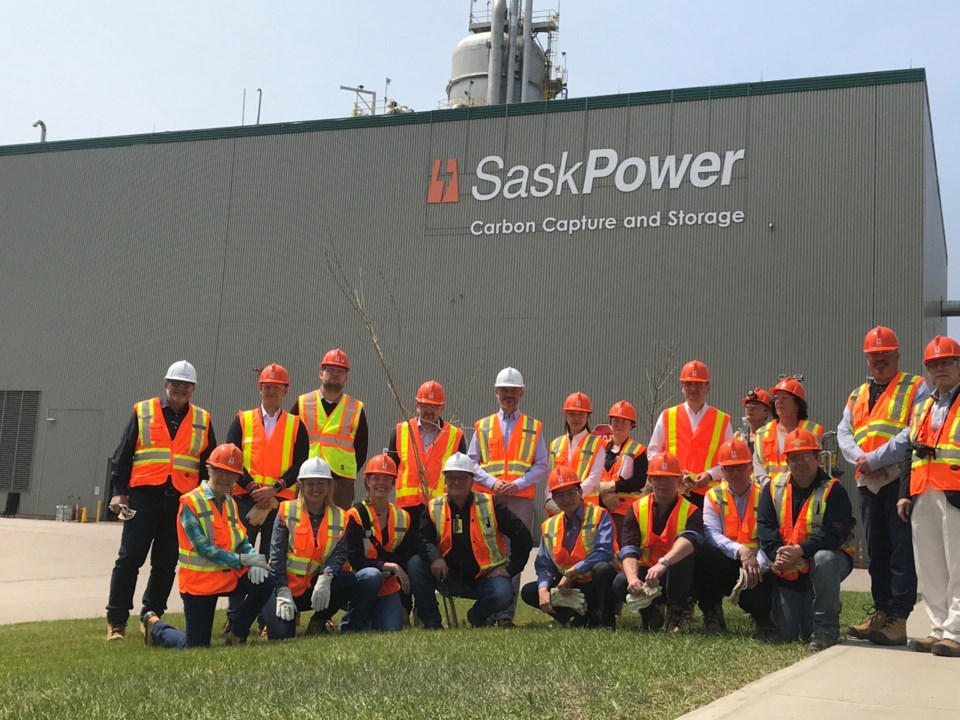The latest delegation to tour the Boundary Dam Power Station’s carbon capture and storage (CCS) facility came away marvelling at the concept and its technology.
Visiting members of a COP24 delegation were at Boundary Dam on Thursday.
Michał Kurtyka, COP24 president and state secretary in the Ministry of Environment of Poland, and Paweł Leszczyński, the director of the COP24 Presidency Bureau and Ministry of Environment of Poland, were among those who toured the facility.
They also visited the carbon capture test facility at the Shand Power Station.
Kurtyka met with the media the following day. He was joined by Dustin Duncan, who is the provincial minister of the Environment as well as the minister responsible for SaskPower.
Duncan said they had a very productive meeting to talk about CCS and some of the other initiatives when it comes to fighting climate change.
“I really can’t say enough about having the president of COP 24 here in Saskatchewan and the entire delegation from Poland, and seeing first hand what we’re doing in Saskatchewan, and hopefully building what I think will be a very fruitful relationship into the future,” said Duncan.
Kurtyka said he was pleased to see the advances that have been taking place in CCS, in which Saskatchewan and SaskPower are global leaders. And he was pleased to attend a clean energy session in Vancouver a few days earlier.
“It’s extremely important, and we all know how many challenges are in front of us in terms of energy transition … but societal transition is ahead of us, and in all of this, you are taking a leading role,” said Kurtyka.
Poland is very interested in CCS technology, and there were talks about future collaborations with Saskatchewan.
“Poland is having lots of interest, but also lots of scientific abilities, so there are lots of pilot projects which were made in Poland, but not at the scale of what is happening at Boundary Dam in Saskatchewan,” he said.
While the CCS facility at Boundary Dam was an expensive project, Kurtyka pointed out the cost is going down.
“We are part of the European Union, and within the European Union, we share a number of research projects,” said Kurtyka. “So I think it’s worthwhile to think about the project that could be located in Poland.”
What’s happening in Saskatchewan is not only important from the perspective of an existing facility, but also in terms of research, proving that the cost continues to go down.
Once they get past the cost, they will need to discuss the strategy to be adopted. The EU is talking about the transition towards renewables, as they want to have 32 per cent of their power generation comes from renewables by 2030.
“Carbon capture and sequestration will be important to make an advance to carbon neutrality,” he said.

Norway and Germany have also moved forward on CCS technology. China and Japan have also investigated the technology.
As for whether he’s concerned that BD3 missed its quota the last two years for captured carbon dioxide, Kurtyka pointed out it’s tough to be the first facility of its kind in the world.
“I’ve seen all of the upgrades and developments that were brought during the project, so it’s not a facility that can be assessed as finished. I think it serves as a lessons learned, as input for the design of future installations,” said Kurtyka.
Promoting CCS technology is not only a big role for SaskPower and the provincial government, according to Duncan, but it’s also big for the CCS Knowledge Centre in trying to transfer knowledge around the world.
He believes SaskPower has been very open in discussing the technology, its advancements and its challenges, since it is first-generation technology.
“The first computer that was ever made, good thing we never stopped with that one, just because we had a few problems,” said Duncan. “We’d never have iPhones and iPads today.”
Duncan praised the CCS Knowledge Centre for trying to transfer that knowledge as quickly as possible around the world so that they can see further deployment of CCS technology to bring costs down in a world that is not moving away from coal-fired power.
“If coal is going to be part of the worldwide mix while we’re all trying to reduce our emissions, and bring on more renewables and bring on lower emission sources … the technology is really key to that,” said Duncan.
The intent of the knowledge centre is to remove as many barriers as possible for transferring that knowledge moving forward, and to deploy knowledge and learnings from operating BD3.
Duncan said there is still interest at a federal level in Boundary Dam. He expects that interest will grow thanks to the efforts of the knowledge centre and SaskPower.
There is also time to see if the federal government would be interested in helping with the costs of a possible retrofit of the Shand Power Station. Boundary Dam 3 received such an investment from the federal Conservative government back in 2008.
“We would be hopeful that the federal government would want to be a partner with us in some way, particularly on the capital side, but I think it’s too early to say at this point,” said Duncan.
Duncan said he is looking forward to meeting with Catherine McKenna, the federal minister of the environment and Climate Change.
“We’ll be happily sharing the fact that we’ve had the opportunity to meet today,” said Duncan.
The delegates from Poland were also joined on their visit by COP24 presidency spokesperson Magda Smokowska, Polish Mining Group chairman of the board Tomasz Rogala, Polish Mining Group management board attorney Adam Milczarczyk, Polish Mining Group director for innovation and new technologies Rafał Gąsior, Central Mining Institute scientific secretary professor Adam Smoliński and Central Mining Institute head professor Stanisław Prusek.




